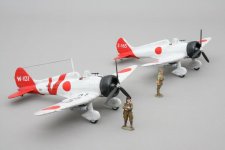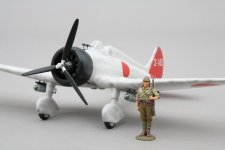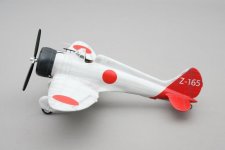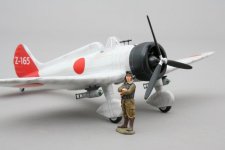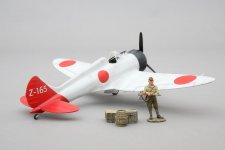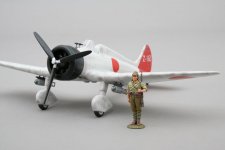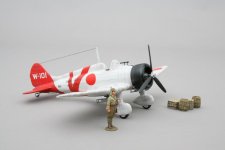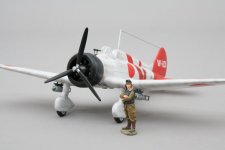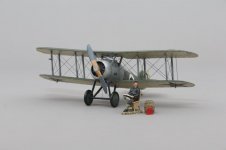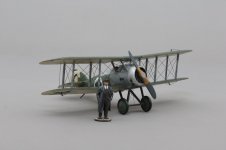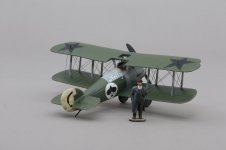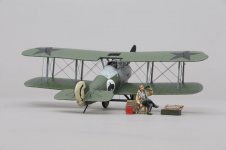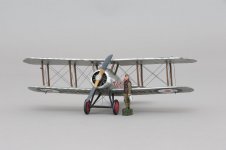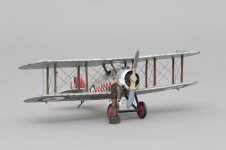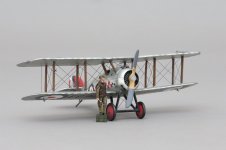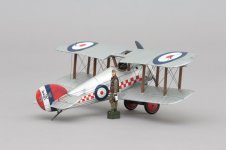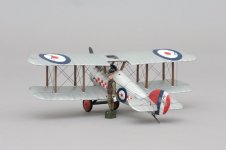The Mitsubishi A5M Navy Type 96 Carrier-based Fighter, company designation Mitsubishi Ka-14, was a Japanese carrier-based fighter aircraft. It was the world's first monoplane shipboard fighter to enter service and the direct predecessor of the famous Mitsubishi A6M "Zero". The Allied reporting name was Claude.
The aircraft entered service in early 1937, and soon saw action in aerial battles at the start of the Second Sino-Japanese War, including air-to-air battles with the Republic of China Air Force's Boeing P-26C Model 281 "Peashooters" in the world's first aerial dogfighting and kills between monoplane fighters built of mostly metal.
Chinese Nationalist pilots, primarily flying the Curtiss Hawk III, fought against the Japanese, but the A5M was the better of almost every fighter aircraft it encountered. Though armed with only a pair of 7.7 mm machine-guns, the new fighter proved effective and damage-tolerant, with excellent manoeuvrability and robust construction. Later on A5M's also provided much-needed escorts for the then-modern but vulnerable Mitsubishi G3M bombers. The Mitsubishi team continued to improve the A5M, working through versions until the final A5M4, which carried an external underside drop tank to provide fuel for extended range.
The A5M's most competitive adversary in the China air war was the Polikarpov I-16, a fast and heavily armed fighter flown by both Chinese Air Force regulars and Soviet volunteers. Air battles in 1938, especially on 18 February and 29 April, ranked among the largest air battles ever fought at the time. The battle of 29 April saw 67 Polikarpov fighters (31 I-16s and 36 I-15 bis) against 18 G3Ms escorted by 27 A5Ms. Each side claimed victory: the Chinese/Soviet side claimed 21 Japanese aircraft (11 fighters and 10 bombers) shot down with 50 Japanese airmen killed and two captured having bailed out while losing 12 aircraft and 5 pilots killed; the Japanese claimed they lost only two G3Ms and two A5Ms shot down with over 40 Chinese aircraft shot down.
Almost all A5Ms had open cockpits. A closed cockpit was tried but found little favor among Navy aviators. All had fixed, non-retractable undercarriage, wheel spats were a feature of standard fighters but not training aircraft.
A5Ms remained in service at the beginning of the Pacific war, US intelligence sources believed the A5M still served as Japan's primary Navy fighter, when in fact the A6M 'Zero' had replaced most of the Claudes on first-line aircraft carriers. However Japanese carriers and Kōkūtai (air groups) continued to use the A5M until production of the Zero caught up with demand. On 1 February 1942, the US carrier USS Enterprise launched air-strikes at Japanese air & naval bases on Roi and Kwajalein Atolls in the Gilbert Islands. During these actions, Mitsubishi A5Ms shot down three Douglas SBD dive-bombers, including the aircraft of Lt-Cdr Halstead Hopping, CO of VS-6 Squadron. The last combat actions with the A5M as a fighter took place at the Battle of the Coral Sea on 7 May 1942, when two A5Ms and four A6Ms of the Japanese carrier Shōhō fought against US aircraft that sank their carrier. In the closing months of the war most remaining A5M airframes were used for kamikaze attacks.
Our 1/30 scale Claudes come in 2 different liveries, WOW192 in the very colourful markings of an aircraft based on the Carrier Soryu during the Pearl Harbour attack and WOW193 in more traditional muted Japanese naval colour scheme, flown by Boatswain Kuniyoshi Tanaka an ace with 17 aerial victories who later went onto fly the A5’s successor, the mighty Zero. Limited to 8 each in number, each model is also supplied with Japanese sentry figure RS053 to add more realism to your diorama. Both Claudes are priced at $499 plus $100 postage if you live in the USA or Australia, for those of you in Europe or UK please contact us for an individual quote as postage will vary depending on where you live.
